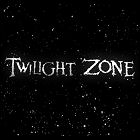 The 118th episode of Rod Serling’s The Twilight Zone airs on CBS. James Whitmore and Tim O’Connor star in an episode written by Serling.
The 118th episode of Rod Serling’s The Twilight Zone airs on CBS. James Whitmore and Tim O’Connor star in an episode written by Serling.
This series is not fully chronicled in the LogBook. You could join theLogBook team and write this guide or support the webmaster’s efforts to expand the site.
More about The Twilight Zone in the LogBook and theLogBook.com Store
The Twilight Zone now streaming on Paramount Plus

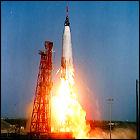 The final manned Mercury flight, Mercury 9 (nicknamed Faith 7) puts astronaut Gordon Cooper in orbit for over a day. Over the course of 34 hours, Cooper circles Earth 22 times, performing small-scale experiments and photography tasks. With Mercury astronaut Deke Slayton grounded due to health issues, only six of the Mercury seven have flown. Development of a two-seater descendant of the Mercury design (initially called “Big Mercury” but now known as Gemini) is well underway, along with the development of the Apollo spacecraft that will succeed Gemini and take men to the moon. Cooper is the last solo American space pilot until Mike Melvill flies the experimental SpaceShip One into suborbital space in the 21st century.
The final manned Mercury flight, Mercury 9 (nicknamed Faith 7) puts astronaut Gordon Cooper in orbit for over a day. Over the course of 34 hours, Cooper circles Earth 22 times, performing small-scale experiments and photography tasks. With Mercury astronaut Deke Slayton grounded due to health issues, only six of the Mercury seven have flown. Development of a two-seater descendant of the Mercury design (initially called “Big Mercury” but now known as Gemini) is well underway, along with the development of the Apollo spacecraft that will succeed Gemini and take men to the moon. Cooper is the last solo American space pilot until Mike Melvill flies the experimental SpaceShip One into suborbital space in the 21st century. Toho Studios release
Toho Studios release  The Soviet Union launches the Vostok 5 mission to orbit Earth, carrying cosmonaut Valery Bykovsky aboard. He remains in orbit for over four days, traveling over 2,000,000 miles in Earth orbit. As he flies over the Soviet Union, a second Vostok capsule is launched in the USSR’s first bid to trump the United States by mounting the first manned space rendezvous.
The Soviet Union launches the Vostok 5 mission to orbit Earth, carrying cosmonaut Valery Bykovsky aboard. He remains in orbit for over four days, traveling over 2,000,000 miles in Earth orbit. As he flies over the Soviet Union, a second Vostok capsule is launched in the USSR’s first bid to trump the United States by mounting the first manned space rendezvous. While cosmonaut Valery Bykovsky orbits overhead about Vostok 5, Vostok 6 is launched from the Soviet Union, carrying the first female space traveler, cosmonaut Valentina Tereshkova. Spending nearly three days in orbit, Tereshkova’s Vostok capsule serves as a rendezvous target for Vostok 5, though without precision piloting ability, the two vehicles’ closest approach is no closer than within three miles, and neither Vostok is actually equipped for any kind of docking. Tereshkova’s flight is a political point scored for the Soviet Union, but only a brief victory for womankind: it will be two more decades before another woman flies in space. The glass ceiling remains firmly in orbit.
While cosmonaut Valery Bykovsky orbits overhead about Vostok 5, Vostok 6 is launched from the Soviet Union, carrying the first female space traveler, cosmonaut Valentina Tereshkova. Spending nearly three days in orbit, Tereshkova’s Vostok capsule serves as a rendezvous target for Vostok 5, though without precision piloting ability, the two vehicles’ closest approach is no closer than within three miles, and neither Vostok is actually equipped for any kind of docking. Tereshkova’s flight is a political point scored for the Soviet Union, but only a brief victory for womankind: it will be two more decades before another woman flies in space. The glass ceiling remains firmly in orbit.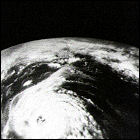 NASA and the United States Weather Bureau launch the seventh experimental TIROS weather satellite, TIROS-7. In addition to observing weather on Earth, TIROS-7 carries instruments to measure electron activity in Earth’s vicinity and to measure the temperature of space. Enhancements designed to extend the satellite’s life prove to be wildly successful: TIROS-7 is the longest-lived of the experimental TIROS series, remaining in service for five years (and, critically, five hurricane seasons).
NASA and the United States Weather Bureau launch the seventh experimental TIROS weather satellite, TIROS-7. In addition to observing weather on Earth, TIROS-7 carries instruments to measure electron activity in Earth’s vicinity and to measure the temperature of space. Enhancements designed to extend the satellite’s life prove to be wildly successful: TIROS-7 is the longest-lived of the experimental TIROS series, remaining in service for five years (and, critically, five hurricane seasons).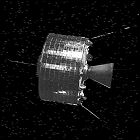 NASA launches the experimental, Hughes Aircraft-built communications satellite Syncom 2 into a geosynchronous orbit, the first human-made satellite to occupy that orbit. (Syncom 1, launched in February, malfunctioned on its way to that orbit, so technically it could be considered the first, though it didn’t arrive in geosynchronous orbit in a functional state.) Capable of handling either a single two-way telephone call, or up to 16 simultaneous teletype transmissions. Early fax transmission tests were also carried out. Syncom 2 could also transmit low-quality video, but with no audio. Control of Syncom 2 is handed over to the Department of Defense in
NASA launches the experimental, Hughes Aircraft-built communications satellite Syncom 2 into a geosynchronous orbit, the first human-made satellite to occupy that orbit. (Syncom 1, launched in February, malfunctioned on its way to that orbit, so technically it could be considered the first, though it didn’t arrive in geosynchronous orbit in a functional state.) Capable of handling either a single two-way telephone call, or up to 16 simultaneous teletype transmissions. Early fax transmission tests were also carried out. Syncom 2 could also transmit low-quality video, but with no audio. Control of Syncom 2 is handed over to the Department of Defense in 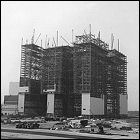 Construction commences on NASA’s massive Vehicle Assembly Building (originally named the Vertical Assembly Building), where the giant Saturn V rockets for Apollo lunar missions will be constructed, tested, and then rolled out to the launch pad atop huge mobile crawlers. Covering eight acres of land on Merritt Island, Florida, the building must withstand Florida’s notorious hurricane seasons (and protect any rockets under construction within) as well as the shockwaves of Saturn V rocket launches taking place only three miles away; special ventilation and humidity control systems have to be built as well, as the interior space is so voluminous that the building has its own internal weather! The VAB will later transition to the assembly of the Space Shuttle launch system elements and the Space Launch System boosters for the 21st century Orion program.
Construction commences on NASA’s massive Vehicle Assembly Building (originally named the Vertical Assembly Building), where the giant Saturn V rockets for Apollo lunar missions will be constructed, tested, and then rolled out to the launch pad atop huge mobile crawlers. Covering eight acres of land on Merritt Island, Florida, the building must withstand Florida’s notorious hurricane seasons (and protect any rockets under construction within) as well as the shockwaves of Saturn V rocket launches taking place only three miles away; special ventilation and humidity control systems have to be built as well, as the interior space is so voluminous that the building has its own internal weather! The VAB will later transition to the assembly of the Space Shuttle launch system elements and the Space Launch System boosters for the 21st century Orion program. Radio and television stations across the United States begin mandatory participation in the national Emergency Broadcast System, a nationwide civil defense alert network replacing the CONELRAD system of the 1950s. Much like CONELRAD, EBS tests and activations initially require the rapid shutdown and reactivation of transmitters, at least until that practice is abolished in favor of a two-tone warning sound in the 1970s. Though the switch from CONELRAD to EBS is sparked by the
Radio and television stations across the United States begin mandatory participation in the national Emergency Broadcast System, a nationwide civil defense alert network replacing the CONELRAD system of the 1950s. Much like CONELRAD, EBS tests and activations initially require the rapid shutdown and reactivation of transmitters, at least until that practice is abolished in favor of a two-tone warning sound in the 1970s. Though the switch from CONELRAD to EBS is sparked by the  NBC premieres
NBC premieres 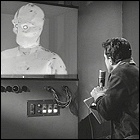 ABC airs the
ABC airs the  NBC airs
NBC airs 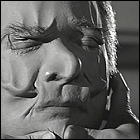 ABC airs the
ABC airs the  The original pilot episode of Doctor Who – version 1.0 of An Unearthly Child – is filmed at the BBC’s Lime Grove Studios. Though it’s substantially the same script as the televised version – barring a line claiming that the Doctor and Susan are from Earth in the 49th century (!) – problems with the sets and props necessitate a complete reshoot on October 18th.
The original pilot episode of Doctor Who – version 1.0 of An Unearthly Child – is filmed at the BBC’s Lime Grove Studios. Though it’s substantially the same script as the televised version – barring a line claiming that the Doctor and Susan are from Earth in the 49th century (!) – problems with the sets and props necessitate a complete reshoot on October 18th. British broadcaster ABC airs the 53rd episode of the spy-fi series The Avengers, starring Patrick Macnee and Honor Blackman. By this episode, which opens the third season, the series has moved firmly into a light-hearted spy-fi vein far removed from its original gritty formulation with two male leads. Where Steed’s sidekicks were on something of a rotation during the second season, Honor Blackman is now the series’ sole female lead.
British broadcaster ABC airs the 53rd episode of the spy-fi series The Avengers, starring Patrick Macnee and Honor Blackman. By this episode, which opens the third season, the series has moved firmly into a light-hearted spy-fi vein far removed from its original gritty formulation with two male leads. Where Steed’s sidekicks were on something of a rotation during the second season, Honor Blackman is now the series’ sole female lead. NBC airs
NBC airs  ABC airs the
ABC airs the  The United States Federal Communications Commission places a ten-year hold on television station licenses for UHF channel 37. Channel 37’s bandwidth, in the 608-614 megahertz range, is vital to the burgeoning science of radio astronomy. The FCC immediately sets about reallocating channels on the UHF dial for 18 television stations across America, which had previously been allocated channel 37 on their licenses. One month later, the ban on broadcasting in that part of the spectrum is made global; no television station in the United States, Mexico, Canada, and several other countries will ever occupy those frequencies. When the ban comes up for review again in
The United States Federal Communications Commission places a ten-year hold on television station licenses for UHF channel 37. Channel 37’s bandwidth, in the 608-614 megahertz range, is vital to the burgeoning science of radio astronomy. The FCC immediately sets about reallocating channels on the UHF dial for 18 television stations across America, which had previously been allocated channel 37 on their licenses. One month later, the ban on broadcasting in that part of the spectrum is made global; no television station in the United States, Mexico, Canada, and several other countries will ever occupy those frequencies. When the ban comes up for review again in  NBC airs
NBC airs 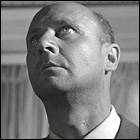 ABC airs the
ABC airs the  NBC airs
NBC airs  ABC airs the
ABC airs the